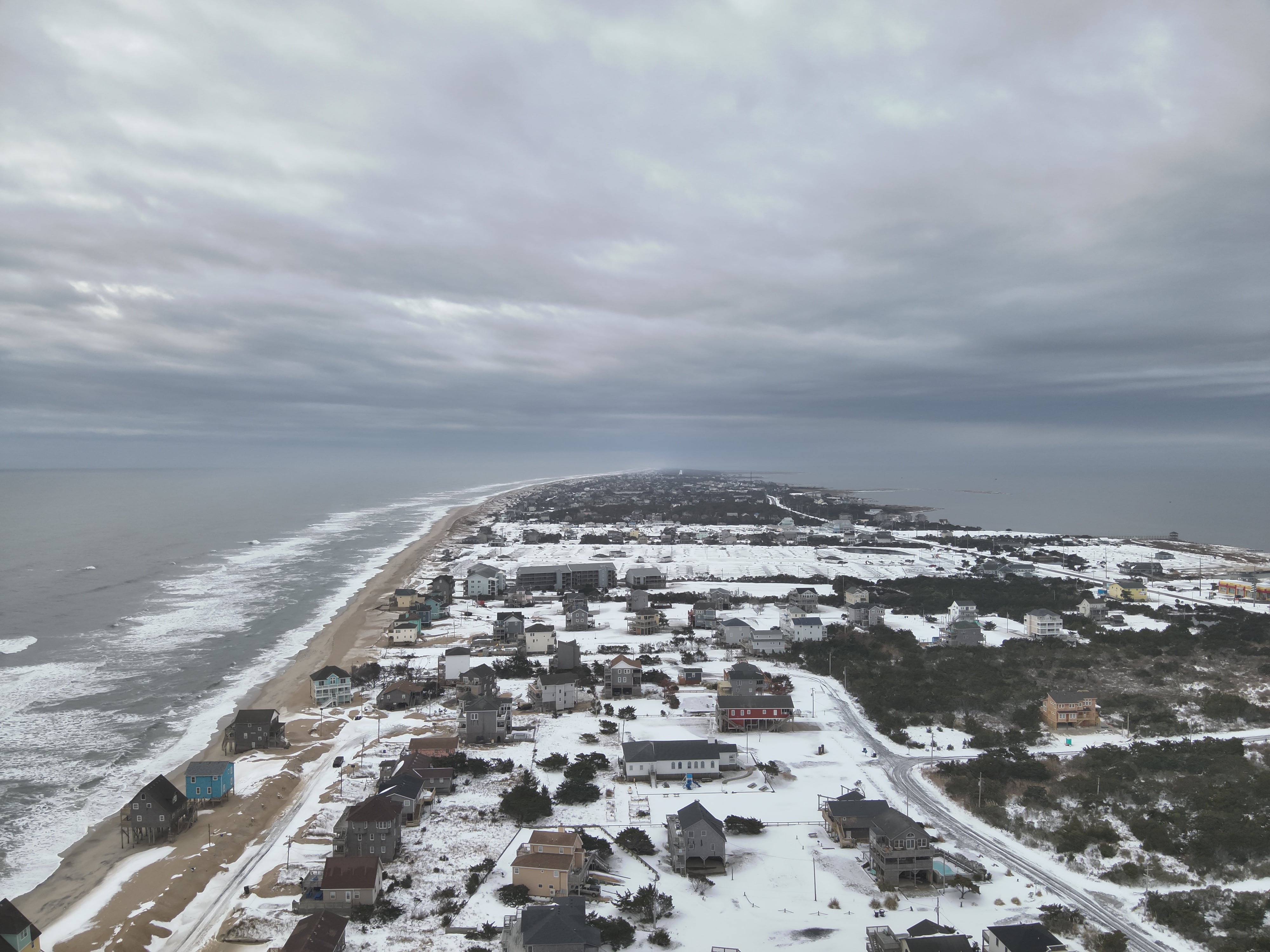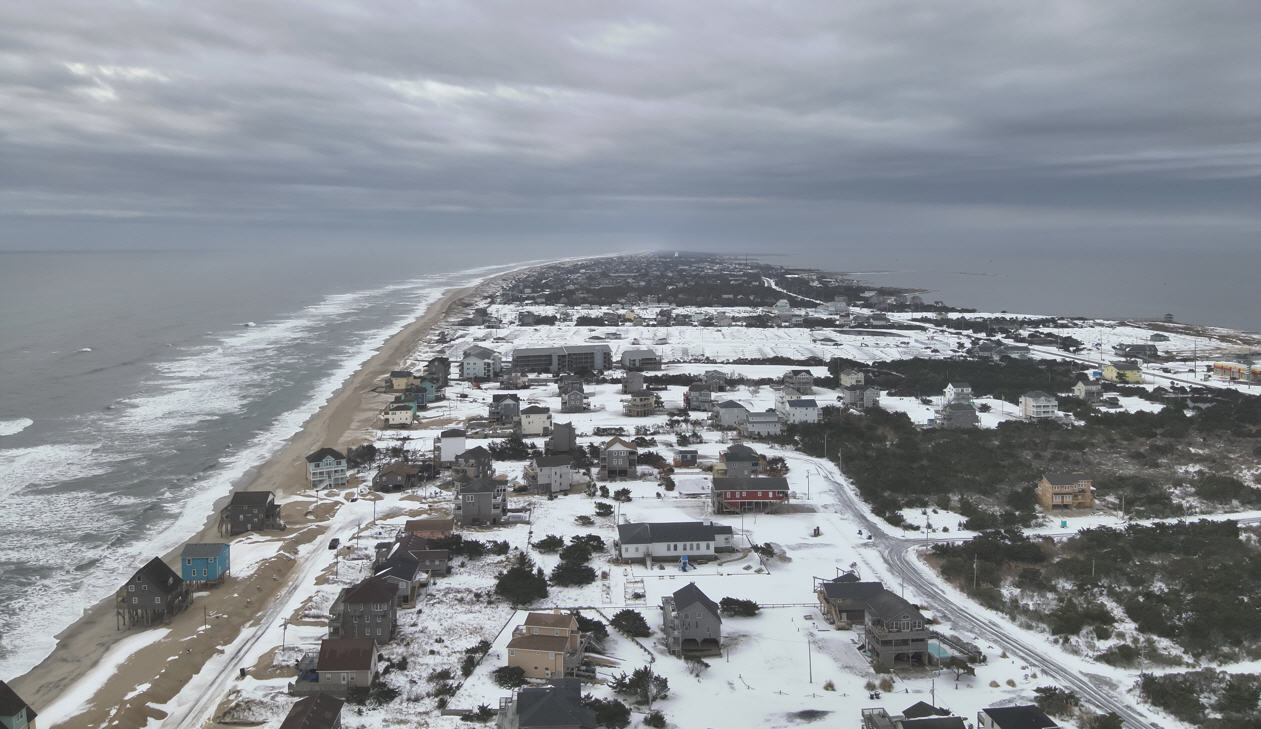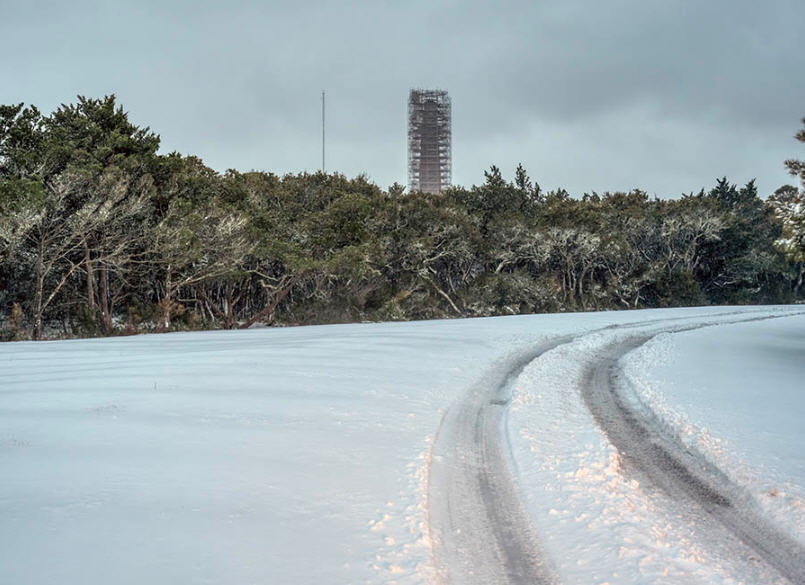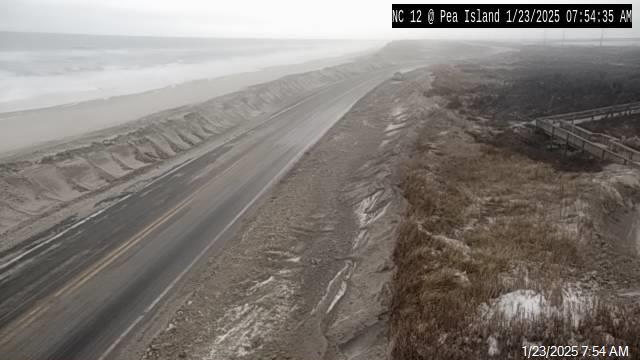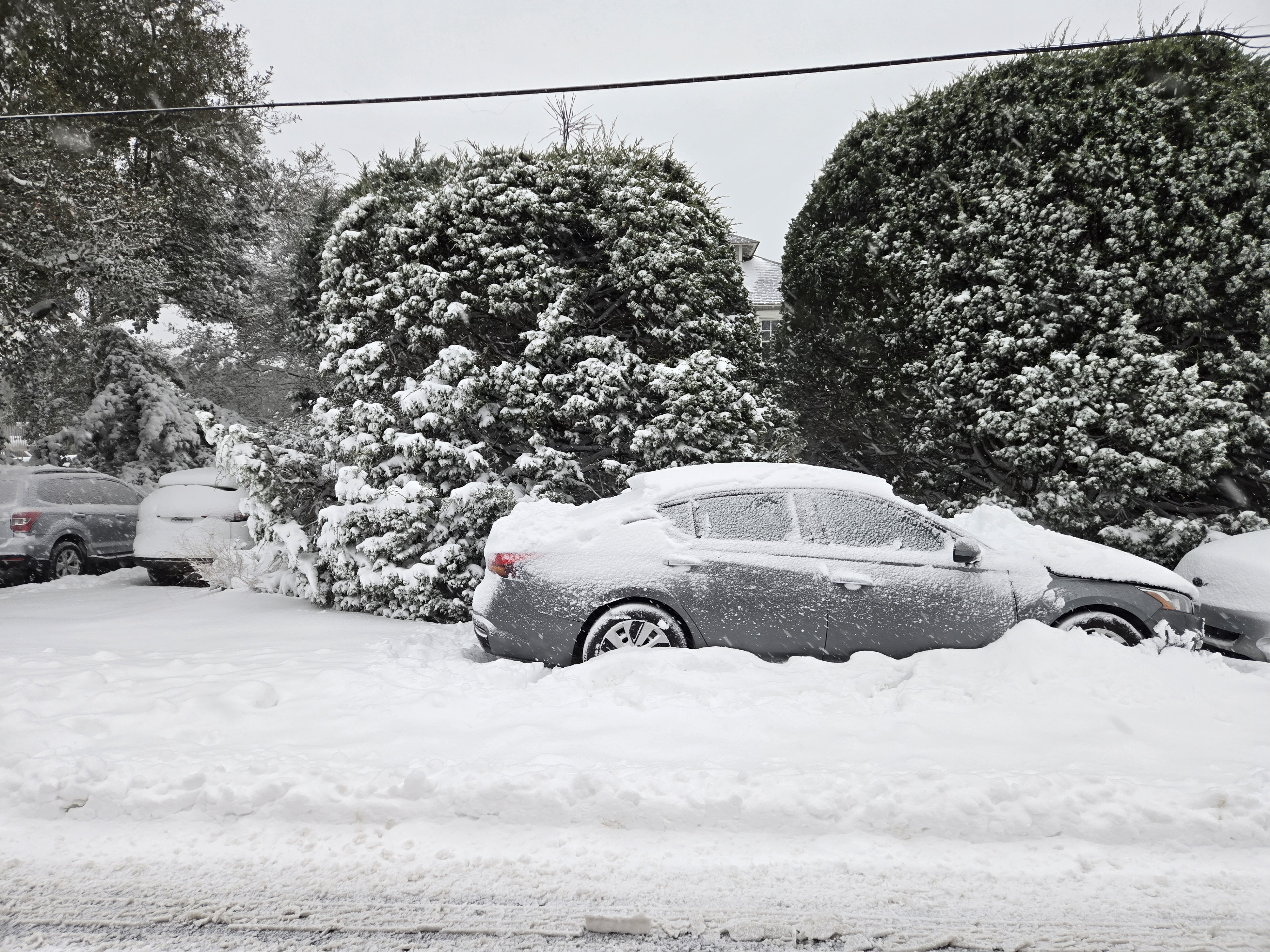Bodie Island Lighthouse is set to have restoration completed and will be open for climbing
The first Bodie Island Lighthouse tipped over. The second one was blown up by soldiers.
The first Bodie Island Lighthouse tipped over. The second one was blown up by soldiers.
The first Bodie Island Lighthouse tipped over. The second one was blown up by soldiers.
The first Bodie Island Lighthouse tipped over. The second one was blown up by soldiers.
But the third one, nearly undone by wicked weather, budget woes, and a bureaucratic tug-of-war, has emerged as the little lighthouse that could.
Restoration of the Bodie Island Lighthouse is as close as it’s ever been to being realized, with only a routine budget procedure to be resolved before the start of the final leg of the project.
“Once we get the account number, we can proceed with the contract,” Doug Stover, National Park Service Outer Banks Group historian, said Thursday.
Stover said the information could come any day.
By the spring of 2013, the 1872 brick beacon is expected to be open for the public to climb for the first time ever. And its spectacular first order Fresnel lens, now repaired and in storage, will have been returned to the lantern room atop the 156-foot tower.
Bett Padgett, president of the Outer Banks Lighthouse Society, is not quite ready to cheer.
“We really, really have high hopes,” Padgett said hesitantly, adding that the group was originally founded in 1994 to save the Bodie lighthouse. “But we have had high hopes for the last 14 years and there has been disappointment.
“This time, I really have my head up to the heavens. I really think it’s going to happen.”
Located in marshlands overlooking Oregon Inlet, the black-and-white banded lighthouse near Nags Head’s southern border had been often treated like the plainer stepsister to taller and more famous Cape Hatteras Lighthouse in Buxton.
While the Hatteras tower was lovingly restored in 1999 during a high-profile $12 million relocation project, Bodie Island eked by on leftovers, leaving Park Service managers enough to do patchwork repairs. Even after the Coast Guard in 2000 gave up ownership of the lighthouse, and later the lens, the Park Service repeatedly was thwarted in its attempts to restore the Bodie tower.
When it was acquired from the Coast Guard, pieces of the cast-iron metalwork were missing at the top and metalwork in the lantern room, gallery deck, and support brackets was deteriorating. Some of the 205 steps in the spiral staircase were corroding. At one point, the Coast Guard, which had maintained control of the navigational aid, wanted the Park Service to replace the historic Fresnel lens with a contemporary light.
But after strong protest, the Coast Guard relented and let the Park Service take over responsibility for the lens, which has since undergone a $100,000 restoration.
Despite chunks of metal falling from the balcony in 2004, it took more than five years to secure $3 million needed to restore the tower. But the project that began in 2009 had to be delayed after additional damage was found in the lighthouse, including its framing, support beams and masonry.
Last year, while the Park Service worked out budgetary issues, all the scaffolding that had surrounded the lighthouse was taken down.
Stover said that about $1.9 million has been secured to finish the restoration. The first task will be putting back the scaffolding. But the most time-consuming part of the project — getting the metalwork done at the foundry — has been completed. The windows have been fixed and delivered to the museum storage facility on Roanoke Island.
But the third one, nearly undone by wicked weather, budget woes, and a bureaucratic tug-of-war, has emerged as the little lighthouse that could.
Restoration of the Bodie Island Lighthouse is as close as it’s ever been to being realized, with only a routine budget procedure to be resolved before the start of the final leg of the project.
“Once we get the account number, we can proceed with the contract,” Doug Stover, National Park Service Outer Banks Group historian, said Thursday.
Stover said the information could come any day.
By the spring of 2013, the 1872 brick beacon is expected to be open for the public to climb for the first time ever. And its spectacular first order Fresnel lens, now repaired and in storage, will have been returned to the lantern room atop the 156-foot tower.
Bett Padgett, president of the Outer Banks Lighthouse Society, is not quite ready to cheer.
“We really, really have high hopes,” Padgett said hesitantly, adding that the group was originally founded in 1994 to save the Bodie lighthouse. “But we have had high hopes for the last 14 years and there has been disappointment.
“This time, I really have my head up to the heavens. I really think it’s going to happen.”
Located in marshlands overlooking Oregon Inlet, the black-and-white banded lighthouse near Nags Head’s southern border had been often treated like the plainer stepsister to taller and more famous Cape Hatteras Lighthouse in Buxton.
While the Hatteras tower was lovingly restored in 1999 during a high-profile $12 million relocation project, Bodie Island eked by on leftovers, leaving Park Service managers enough to do patchwork repairs. Even after the Coast Guard in 2000 gave up ownership of the lighthouse, and later the lens, the Park Service repeatedly was thwarted in its attempts to restore the Bodie tower.
When it was acquired from the Coast Guard, pieces of the cast-iron metalwork were missing at the top and metalwork in the lantern room, gallery deck, and support brackets was deteriorating. Some of the 205 steps in the spiral staircase were corroding. At one point, the Coast Guard, which had maintained control of the navigational aid, wanted the Park Service to replace the historic Fresnel lens with a contemporary light.
But after strong protest, the Coast Guard relented and let the Park Service take over responsibility for the lens, which has since undergone a $100,000 restoration.
Despite chunks of metal falling from the balcony in 2004, it took more than five years to secure $3 million needed to restore the tower. But the project that began in 2009 had to be delayed after additional damage was found in the lighthouse, including its framing, support beams and masonry.
Last year, while the Park Service worked out budgetary issues, all the scaffolding that had surrounded the lighthouse was taken down.
Stover said that about $1.9 million has been secured to finish the restoration. The first task will be putting back the scaffolding. But the most time-consuming part of the project — getting the metalwork done at the foundry — has been completed. The windows have been fixed and delivered to the museum storage facility on Roanoke Island.
But the third one, nearly undone by wicked weather, budget woes, and a bureaucratic tug-of-war, has emerged as the little lighthouse that could.
Restoration of the Bodie Island Lighthouse is as close as it’s ever been to being realized, with only a routine budget procedure to be resolved before the start of the final leg of the project.
“Once we get the account number, we can proceed with the contract,” Doug Stover, National Park Service Outer Banks Group historian, said Thursday.
Stover said the information could come any day.
By the spring of 2013, the 1872 brick beacon is expected to be open for the public to climb for the first time ever. And its spectacular first order Fresnel lens, now repaired and in storage, will have been returned to the lantern room atop the 156-foot tower.
Bett Padgett, president of the Outer Banks Lighthouse Society, is not quite ready to cheer.
“We really, really have high hopes,” Padgett said hesitantly, adding that the group was originally founded in 1994 to save the Bodie lighthouse. “But we have had high hopes for the last 14 years and there has been disappointment.
“This time, I really have my head up to the heavens. I really think it’s going to happen.”
Located in marshlands overlooking Oregon Inlet, the black-and-white banded lighthouse near Nags Head’s southern border had been often treated like the plainer stepsister to taller and more famous Cape Hatteras Lighthouse in Buxton.
While the Hatteras tower was lovingly restored in 1999 during a high-profile $12 million relocation project, Bodie Island eked by on leftovers, leaving Park Service managers enough to do patchwork repairs. Even after the Coast Guard in 2000 gave up ownership of the lighthouse, and later the lens, the Park Service repeatedly was thwarted in its attempts to restore the Bodie tower.
When it was acquired from the Coast Guard, pieces of the cast-iron metalwork were missing at the top and metalwork in the lantern room, gallery deck, and support brackets was deteriorating. Some of the 205 steps in the spiral staircase were corroding. At one point, the Coast Guard, which had maintained control of the navigational aid, wanted the Park Service to replace the historic Fresnel lens with a contemporary light.
But after strong protest, the Coast Guard relented and let the Park Service take over responsibility for the lens, which has since undergone a $100,000 restoration.
Despite chunks of metal falling from the balcony in 2004, it took more than five years to secure $3 million needed to restore the tower. But the project that began in 2009 had to be delayed after additional damage was found in the lighthouse, including its framing, support beams and masonry.
Last year, while the Park Service worked out budgetary issues, all the scaffolding that had surrounded the lighthouse was taken down.
Stover said that about $1.9 million has been secured to finish the restoration. The first task will be putting back the scaffolding. But the most time-consuming part of the project — getting the metalwork done at the foundry — has been completed. The windows have been fixed and delivered to the museum storage facility on Roanoke Island.
But the third one, nearly undone by wicked weather, budget woes, and a bureaucratic tug-of-war, has emerged as the little lighthouse that could.
Restoration of the Bodie Island Lighthouse is as close as it’s ever been to being realized, with only a routine budget procedure to be resolved before the start of the final leg of the project.
“Once we get the account number, we can proceed with the contract,” Doug Stover, National Park Service Outer Banks Group historian, said Thursday.
Stover said the information could come any day.
By the spring of 2013, the 1872 brick beacon is expected to be open for the public to climb for the first time ever. And its spectacular first order Fresnel lens, now repaired and in storage, will have been returned to the lantern room atop the 156-foot tower.
Bett Padgett, president of the Outer Banks Lighthouse Society, is not quite ready to cheer.
“We really, really have high hopes,” Padgett said hesitantly, adding that the group was originally founded in 1994 to save the Bodie lighthouse. “But we have had high hopes for the last 14 years and there has been disappointment.
“This time, I really have my head up to the heavens. I really think it’s going to happen.”
Located in marshlands overlooking Oregon Inlet, the black-and-white banded lighthouse near Nags Head’s southern border had been often treated like the plainer stepsister to taller and more famous Cape Hatteras Lighthouse in Buxton.
While the Hatteras tower was lovingly restored in 1999 during a high-profile $12 million relocation project, Bodie Island eked by on leftovers, leaving Park Service managers enough to do patchwork repairs. Even after the Coast Guard in 2000 gave up ownership of the lighthouse, and later the lens, the Park Service repeatedly was thwarted in its attempts to restore the Bodie tower.
When it was acquired from the Coast Guard, pieces of the cast-iron metalwork were missing at the top and metalwork in the lantern room, gallery deck, and support brackets was deteriorating. Some of the 205 steps in the spiral staircase were corroding. At one point, the Coast Guard, which had maintained control of the navigational aid, wanted the Park Service to replace the historic Fresnel lens with a contemporary light.
But after strong protest, the Coast Guard relented and let the Park Service take over responsibility for the lens, which has since undergone a $100,000 restoration.
Despite chunks of metal falling from the balcony in 2004, it took more than five years to secure $3 million needed to restore the tower. But the project that began in 2009 had to be delayed after additional damage was found in the lighthouse, including its framing, support beams and masonry.
Last year, while the Park Service worked out budgetary issues, all the scaffolding that had surrounded the lighthouse was taken down.
Stover said that about $1.9 million has been secured to finish the restoration. The first task will be putting back the scaffolding. But the most time-consuming part of the project — getting the metalwork done at the foundry — has been completed. The windows have been fixed and delivered to the museum storage facility on Roanoke Island.
“So it’s pretty much just getting all the jigsaw pieces and putting it all together,” he said.
“So it’s pretty much just getting all the jigsaw pieces and putting it all together,” he said.
“So it’s pretty much just getting all the jigsaw pieces and putting it all together,” he said.
“So it’s pretty much just getting all the jigsaw pieces and putting it all together,” he said.
Meanwhile, repairs at the double-keepers quarters at the Light Station is being done, Stover said.
Meanwhile, repairs at the double-keepers quarters at the Light Station is being done, Stover said.
Meanwhile, repairs at the double-keepers quarters at the Light Station is being done, Stover said.
Meanwhile, repairs at the double-keepers quarters at the Light Station is being done, Stover said.
Hurricane Irene in August flooded the Visitor Center, buckling the wooden floors. Winds blew off the canvas covering the windows atop the lighthouse, and floodwaters relocated all the parking lot barriers into the adjacent swamps.
Hurricane Irene in August flooded the Visitor Center, buckling the wooden floors. Winds blew off the canvas covering the windows atop the lighthouse, and floodwaters relocated all the parking lot barriers into the adjacent swamps.
Hurricane Irene in August flooded the Visitor Center, buckling the wooden floors. Winds blew off the canvas covering the windows atop the lighthouse, and floodwaters relocated all the parking lot barriers into the adjacent swamps.
Hurricane Irene in August flooded the Visitor Center, buckling the wooden floors. Winds blew off the canvas covering the windows atop the lighthouse, and floodwaters relocated all the parking lot barriers into the adjacent swamps.
The Visitor Center will remain closed for the next couple of months, he said, but visitors are permitted on the grounds.
The Visitor Center will remain closed for the next couple of months, he said, but visitors are permitted on the grounds.
The Visitor Center will remain closed for the next couple of months, he said, but visitors are permitted on the grounds.
The Visitor Center will remain closed for the next couple of months, he said, but visitors are permitted on the grounds.
When the lighthouse restoration is completed, hopefully by spring 2013 Stover said, it is expected to be opened for climbing for probably about the same fee it costs to climb the Cape Hatteras Lighthouse. But the numbers of climbers are expected to be more restricted than Hatteras, he said.
When the lighthouse restoration is completed, hopefully by spring 2013 Stover said, it is expected to be opened for climbing for probably about the same fee it costs to climb the Cape Hatteras Lighthouse. But the numbers of climbers are expected to be more restricted than Hatteras, he said.
When the lighthouse restoration is completed, hopefully by spring 2013 Stover said, it is expected to be opened for climbing for probably about the same fee it costs to climb the Cape Hatteras Lighthouse. But the numbers of climbers are expected to be more restricted than Hatteras, he said.
When the lighthouse restoration is completed, hopefully by spring 2013 Stover said, it is expected to be opened for climbing for probably about the same fee it costs to climb the Cape Hatteras Lighthouse. But the numbers of climbers are expected to be more restricted than Hatteras, he said.
Padgett said that she expects that Bodie Island Lighthouse, which is one of the few in the nation with its original Fresnel lens, will quickly become very popular.
Padgett said that she expects that Bodie Island Lighthouse, which is one of the few in the nation with its original Fresnel lens, will quickly become very popular.
Padgett said that she expects that Bodie Island Lighthouse, which is one of the few in the nation with its original Fresnel lens, will quickly become very popular.
Padgett said that she expects that Bodie Island Lighthouse, which is one of the few in the nation with its original Fresnel lens, will quickly become very popular.
The view from the top features a panorama of the sound, the marshland , the ocean, Oregon Inlet and the Bonner Bridge. If it’s opened in the evening like at Cape Hatteras for special events, climbers can be treated to glorious sunsets and full moons.
“I imagine it’s going to be one of the largest draws for lighthouses in the United States,” she said. “It’s very special.”
The view from the top features a panorama of the sound, the marshland , the ocean, Oregon Inlet and the Bonner Bridge. If it’s opened in the evening like at Cape Hatteras for special events, climbers can be treated to glorious sunsets and full moons.
“I imagine it’s going to be one of the largest draws for lighthouses in the United States,” she said. “It’s very special.”
The view from the top features a panorama of the sound, the marshland , the ocean, Oregon Inlet and the Bonner Bridge. If it’s opened in the evening like at Cape Hatteras for special events, climbers can be treated to glorious sunsets and full moons.
“I imagine it’s going to be one of the largest draws for lighthouses in the United States,” she said. “It’s very special.”
The view from the top features a panorama of the sound, the marshland , the ocean, Oregon Inlet and the Bonner Bridge. If it’s opened in the evening like at Cape Hatteras for special events, climbers can be treated to glorious sunsets and full moons.
“I imagine it’s going to be one of the largest draws for lighthouses in the United States,” she said. “It’s very special.”
Subject
Name
(required, will not be published)
(required, will not be published)
City :
State :
Your Comments:
May be posted on the Letters to the Editor page at the discretion of the editor.
May be posted on the Letters to the Editor page at the discretion of the editor.
May be posted on the Letters to the Editor page at the discretion of the editor.
May be posted on the Letters to the Editor page at the discretion of the editor.










